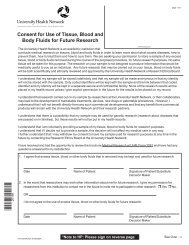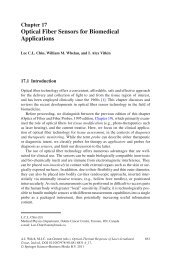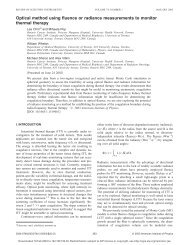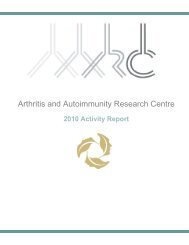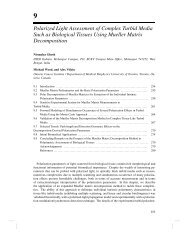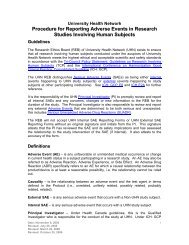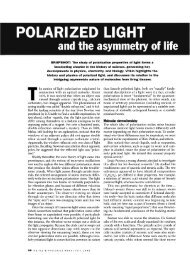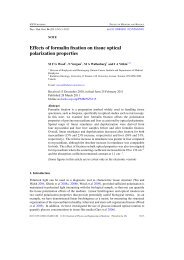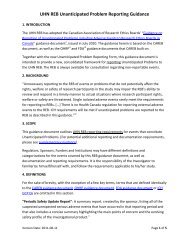Download the 2005 pdf - UHN Research
Download the 2005 pdf - UHN Research
Download the 2005 pdf - UHN Research
You also want an ePaper? Increase the reach of your titles
YUMPU automatically turns print PDFs into web optimized ePapers that Google loves.
<strong>UHN</strong>+ PARTNERS=<br />
New Clinical Products<br />
Metastasis of tumours to <strong>the</strong><br />
spine is a debilitating outcome<br />
for many women<br />
with breast cancer, as well as for<br />
women and men with several o<strong>the</strong>r<br />
types of cancer. <strong>UHN</strong> researchers, in<br />
partnership with Sunnybrook and<br />
Women’s College Health Sciences<br />
Centre and University of California-<br />
Davis, as well as <strong>the</strong> private sector, are<br />
working on a revolutionary new way<br />
to treat such patients.<br />
The method involves photodynamic<br />
<strong>the</strong>rapy, or PDT, in which a targeted<br />
laser is used to specifically activate a<br />
drug (photosensitizer) that is localized<br />
in cancer cells—while causing<br />
only minimal damage to surrounding<br />
healthy cells.<br />
“PDT is a powerful treatment and<br />
its uses against tumours in various<br />
parts of <strong>the</strong> body are only beginning<br />
to be shown.The challenge, in each<br />
case, is to find a way to shine <strong>the</strong> light<br />
directly on <strong>the</strong> affected organ. Since<br />
laser light does not easily penetrate<br />
deeply into tissues, access is simpler in<br />
some organs, like <strong>the</strong> lungs, gastrointestinal<br />
track and eye, but more difficult<br />
in organs with no external access.<br />
Our technology addresses this in <strong>the</strong><br />
spine,” says Dr. Brian Wilson of OCI/<br />
PMH, who, with colleagues Drs. Shane<br />
Burch, Stuart Bisland and Jeff<br />
Siewerdsen, is leading <strong>the</strong> program.<br />
Their invention, <strong>the</strong> bone screw,<br />
resembles a metallic straw.The screws<br />
can be implanted in affected vertebrae<br />
and used to place optical fibers to<br />
deliver <strong>the</strong> light deep into <strong>the</strong> bone.<br />
This device also allows subsequent<br />
vertebroplasty—injection of a plastic<br />
compound into <strong>the</strong> vertebra—in order<br />
to stabilize and streng<strong>the</strong>n <strong>the</strong> bone<br />
to improve mobility.<br />
A Canadian biopharmaceutical<br />
company, QLT Inc, has a focus in<br />
PDT for cancer and o<strong>the</strong>r diseases<br />
and has joined forces with <strong>the</strong> group<br />
to sponsor a preclinical safety study.<br />
“The results of this study are very<br />
promising in terms of effectiveness<br />
and safety and we’re hoping to move<br />
to clinical trials in humans within <strong>the</strong><br />
next year,” says Dr. Wilson.<br />
Working with <strong>the</strong> <strong>UHN</strong> <strong>Research</strong><br />
Business Development Office, <strong>the</strong><br />
group has applied for a patent on <strong>the</strong><br />
device and has also attracted <strong>the</strong><br />
interest of companies interested in<br />
developing guidance and imaging<br />
software for <strong>the</strong> treatment.<br />
<strong>UHN</strong>+ PARTNERS=<br />
Training <strong>the</strong> Next Generation<br />
University Health Network is a<br />
teaching hospital, meaning<br />
that it takes very seriously<br />
its mandate to train <strong>the</strong> next generation<br />
of health care providers and<br />
biomedical researchers.<br />
Funding for training comes from<br />
a variety of sources. One of <strong>UHN</strong>’s<br />
innovative programs is <strong>the</strong> Strategic<br />
Training Grant in Regenerative<br />
Medicine, funded by <strong>the</strong> Canadian<br />
Institutes of Health <strong>Research</strong>.<br />
Regenerative medicine embraces<br />
ground-breaking new treatments for<br />
organ failure—stem cell <strong>the</strong>rapy,<br />
<strong>the</strong>rapeutic cloning, tissue engineering,<br />
tolerance research, and gene<br />
<strong>the</strong>rapy. Led by world-famous<br />
transplant physician and researcher<br />
Dr. Gary Levy, <strong>the</strong> CIHR training<br />
program is a multi-site (University<br />
of Toronto, McMaster University<br />
and University of Ottawa), multidisciplinary<br />
accredited course for students<br />
interested in obtaining a Master’s or<br />
PhD in regenerative medicine.<br />
Launched in 2002, <strong>the</strong> program<br />
has enjoyed steady growth. It now<br />
boasts fifteen faculty at <strong>UHN</strong> and<br />
o<strong>the</strong>r hospitals, and in <strong>2005</strong> <strong>the</strong> program<br />
funded a total of 24 trainees in<br />
16 labs: four postdoctoral fellows,<br />
fourteen graduate students and six<br />
summer students.<br />
<strong>UHN</strong> researchers also lead two<br />
o<strong>the</strong>r training grants funded under<br />
<strong>the</strong> same CIHR program: a group led<br />
by Dr. Fei-Fei Lui providing training<br />
in radiation medicine and a group<br />
led by Dr. Ming Tsao in molecular<br />
oncologic pathology.<br />
UNIVERSITY HEALTH NETWORK 15






